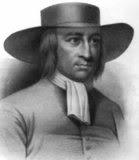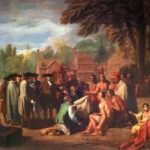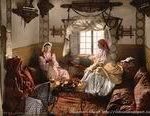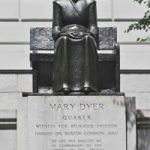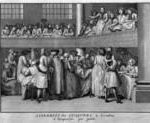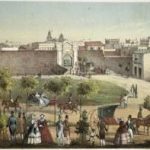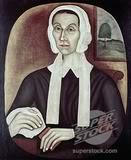Role of Quakers in the American Revolution
Image: Quaker Founder George Fox
The Religious Society of Friends, commonly called Quakers has opposed war and violence from its inception, and has sought instead to do away with the causes of war and alleviate the suffering it causes. George Fox, the founder of the Friends, preached in the 1640s that there was a divine spark within each person, which means that all human beings are infinitely precious in God’s sight, and no one is justified in taking the life of another.
After the restoration of Charles II in 1660, radical religious groups stirred up rebellion, which led Friends to issue a declaration: “We utterly deny all outward wars and strife and fightings with outward weapons….” Eventually, this Peace Testimony became fundamental to Quakerism. George Fox declared in 1684 that “the Spirit of Christ will never move us to fight and war against any man.”
In 1682, William Penn founded his “holy experiment” in Pennsylvania, based on the belief that a province that had no army, treated Native Americans as equals, and offered religious liberty could make the Peace Testimony a living reality.
Although Pennsylvania was drawn into two wars between England and France, the colonists avoided deep involvement, and peace returned in 1713. When the French and Indian War broke out in 1754, most of the Quaker politicians resigned from government for several years rather than support the war.
Conflict with the proprietors, first with Penn and then with his sons, became characteristic as Quakers sought political power and won every assembly election until 1775 on a platform of low taxes, no established church, and no militia. Pennsylvania and Friends prospered, and Philadelphia became a cosmopolitan town with Quakers supporting the American Philosophical Society, the Pennsylvania Hospital, and the Library Company.
Pennsylvania Independence
Even with his death in 1718, William Penn’s Charter of Privileges remained in Pennsylvania until 1776, when the colony declared its independence from England, and formed its own government. The Pennsylvania Constitution was the most democratic of all the colonies, mandating annual elections, and requiring the retirement of legislators after four terms in office, thus subjecting officials to their own laws.
The governor, who never had much power anyway, was completely eliminated, giving all authority to the legislature. Moreover, every bill passed by the General Assembly would have to be printed for consideration by the people at large before it could become law in the next legislative session. The Pennsylvania Constitution completely obliterated privilege, government grants, and chartered monopoly.
Friends and the American Revolution
American Friends supported the protests against British taxation beginning in 1765 until they concluded that the agitation was leading to war. After 1774, Quakers withdrew from politics and opposed the movement toward independence. In 1776, they proclaimed neutrality between the two warring parties, required all members to free their slaves. By 1776, all Quakers in good standing had released their slaves.
For Pennsylvania Quakers – most numerous in the eastern part of state – decisions about whether to support or oppose the war were further complicated by the inherent conflict between two deeply held beliefs: their pacifist principles and their desire to protect and support the colony founded by William Penn.
Largely because of this variety of positions, the perception among both Patriots and Loyalists was that Quakers could not be fully trusted. In the Delaware Valley, where for most of 1776 and 1777 first the British and then the Americans held sway, Quakers were punished by each side for their supposed allegiance to the other.
At the start of the Revolutionary War, the Friends took a neutral position and were persecuted by both British loyalists (Tories) and American Whigs. Quakers did raise money and sent supplies to assist civilians. In 1777, seventeen Philadelphia Quaker leaders were accused of treason and exiled to Virginia by the Whigs, but the following spring the fourteen who survived were released without trial.
Quakers who stuck by the sect’s pacifist teachings had a tough time during the American Revolution, often lumped in as Tories by Patriots, and subject to spasms of popular abuse, official writs confiscating their property, and other indignities. Prejudice occasionally exposed Quakers to the severest punishments for perceived crimes.
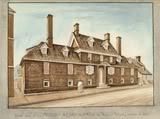
Image: Friends Alms House
by William L. Breton
The Society of Friends established the first alms house for the poor in 1713.
Several hundred Friends, including Betsy Ross, were strongly drawn to the revolutionary cause, and many of them joined the armed forces, notably General Nathaniel Greene from Rhode Island. The Quakers disowned members who served in the military or occupied political office. Almost 1000 Quakers were disowned during the course of the war, the large majority of them for taking up arms.
The American Revolution was a civil war in part, and it divided Quakers just as it divided other groups. A significant minority of the Society of Friends supported the American cause and paid war taxes and even did military service. Some Quakers were conscientiously convinced that they could, despite the Friends’ Peace Testimony, take up arms against the British.
For this, many were disowned by the Quaker communities. In 1781 a few of these people, including seamstress Betsy Ross, broke away and formed the Society of Free Quakers in Philadelphia. This small group was a refuge for the Society of Friends, who actively supported American independence as well as the principles of Quakerism.
Pennsylvania Quakers’ political influence declined during the American Revolution because of their pacifism, but their moral influence in the early republic, and afterwards, remained great. Friends intensified their involvement in both the anti-slavery movement and Indian affairs in the 1800s, and became national leaders in prison reform, care for the mentally ill, and women’s rights. They set up Friends’ Schools to provide education that stressed their principles of pacifism and social action.
Perhaps a number of factors combined to reduce the relative size and influence of the Society of Friends in America during the 1700s. Meanwhile, as the frontier opened up beyond the thirteen colonies, Friends began to move in large numbers into the interior of the continent. Many settled in Ohio and Indiana, and later in Iowa, and in these areas the heartland of American Quakerism developed.
SOURCES
Protestant Denominations
A Holy Experiment in Laissez-Faire
A Fractured History of Quakers in America
Religion and the Founding of the American Republic
